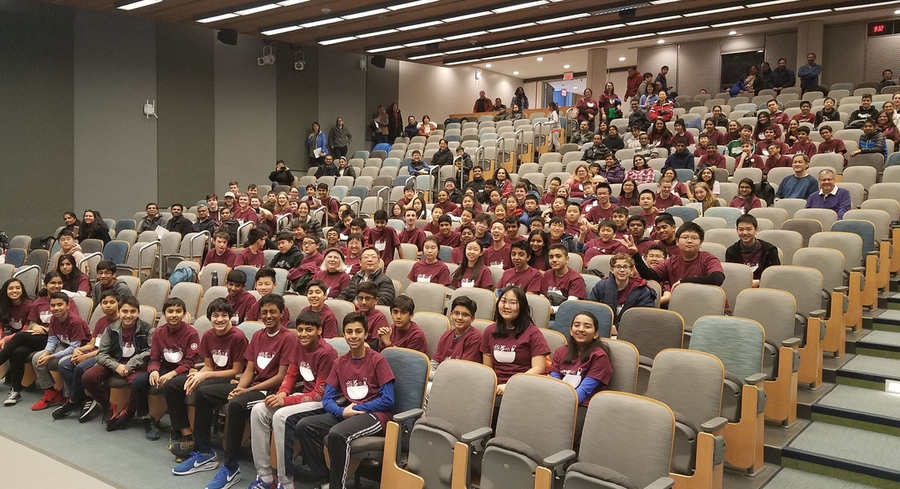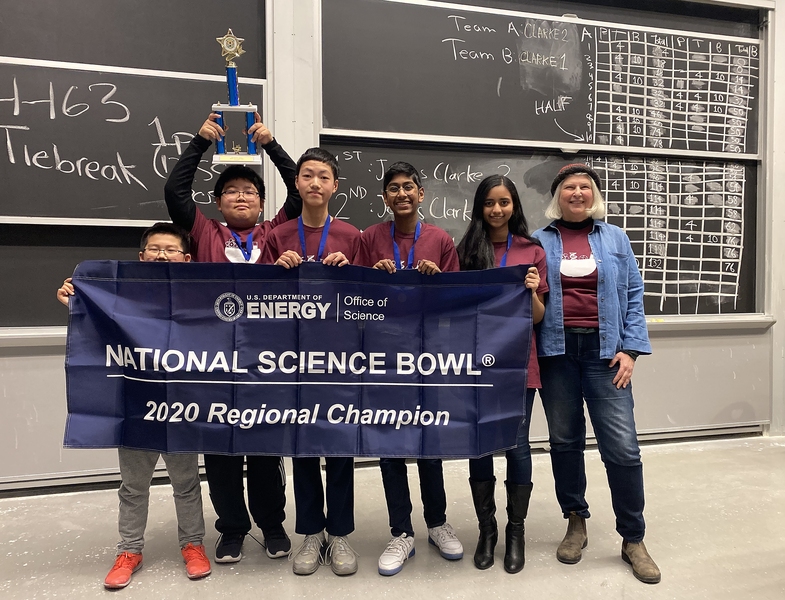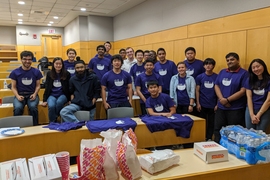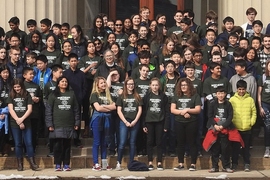More than 100 middle schoolers gathered at MIT to compete in the annual Northeast Regional Middle School Science Bowl. The campus was filled with the sounds of buzzers going off, cheering, and lots of science, math, and engineering.
The Saturday, Feb. 22, event brought together 24 teams from 11 middle schools in Massachusetts, Maine, and New Hampshire. The three teams representing the James F. Doughty School came from Bangor, Maine; they had to wake up at 4 a.m. to be on MIT’s campus in time to register for the competition.
The middle school team from the Roxbury Latin School, an all-boys middle and high school in West Roxbury, Massachusetts, competed for the third time this year. According to Christopher Zhu, a senior at the school who leads the participating team’s weekly practices, the science bowl competitions are a great way to get middle schoolers involved in science. “I would say that one half of the people who do science bowl have a strong personal interest in science and the other half are trying things out,” says Zhu.
“It’s not your stereotypical science classroom,” Zhu says. “It’s a fun and engaging competitive environment that a lot of the younger kids enjoy.” For Robert Moore, who coaches Roxbury Latin’s team, the appeal is the level of excitement generated. “It’s no different than a basketball tournament.”
Those who have experienced the exhilaration of answering the right question and gaining points for their team find it hard to leave science bowl. The Northeast Regional was originated by former MIT undergraduate and alumna of the science bowl Kathleen Schwind. The event is now in its fifth year and, now that Schwind has graduated from MIT, was coordinated and executed by Paolo Adajar, a third-year majoring in mathematical economics; Alborz Bejnood, a computational biologist at the Broad Institute of MIT and Harvard; Andrew Gu, a second-year majoring in mathematics; Sujay Kazi, a third-year double majoring in mathematics and physics; Jushua Park, a second-year majoring in biological engineering; and Mihir Singhal, a second-year majoring in mathematics.
“This is the only science bowl in the nation entirely run by veterans,” says Adajar, who adds that the majority of the volunteers are also alums. For many, organizing science bowl is their way to stay involved and give back to the competition that marked their middle and high school experiences. The MIT School of Science funds the event each year.
The morning began with a series of round-robin style competitions, with the 24 teams divided into groups of six that play against each other, fielding questions from across the STEM universe. Each round involves a number of toss-up questions, which both teams can buzz to answer. These questions are heavily guarded prior to the event, but the U.S. Department of Energy, which organizes science bowl, has sample questions online from previous years. These vary from what type of process is used by nuclear power plants to generate energy (answer: fission) to which cellular organelle is responsible for photosynthesis (answer: chloroplast).
A correctly answered question gains the team four points and the chance to answer a bonus question worth 10 points. While toss-up questions have to be answered individually, bonus questions involve teamwork, with the four team members whispering back and forth, trying to make the most of the 20 seconds they have to agree on an answer. One bonus question from 2017, for instance, asked a team to solve the following equation for x: x2 – 7x – 120 = 0 (Answer: Both -8 and 15, and the team was required to give both answers in order to receive points).
Practice at Roxbury Latin, which started in January, focuses on teaching contestants how to play the game. “The team knows what they know, but they need to learn to listen carefully, to not buzz in too early, to not blurt,” says Moore. “For me, that’s why we practice.”
After a break for lunch, the top two teams from each group headed to the single-elimination bracket, which decided who proceeded to the semi-finals. In the middle of the afternoon, the final winning and third place-deciding matches brought this year’s annual Regional Middle School Science Bowl to a close.
This year, both first and second place went to two teams from Jonas Clarke Middle School in Lexington, Massachusetts. Clarke Team 2 came in first, while Clarke Team 1 came in second. The winning team received not only the “fame and glory of winning the coolest science bowl in all the nation,” according to Adajar, but they will also go on to represent the Northeast in the National Science Bowl in Washington in April.
Roxbury Latin’s team did not go to the single-elimination round and over lunch, two of the team’s eighth-graders analyzed their performance. “We were zero-to-two after the first two rounds, then came back to two-for-two, and the last round was really close,” said one student. “That was a confidence hit, but the questions got easier and we got more aggressive with the buzzing,” added another team member. Ending the tournament two wins to three losses may have been disappointing, but when asked about their plans for next year there was no hesitation. “We’re definitely doing science bowl in high school.”










